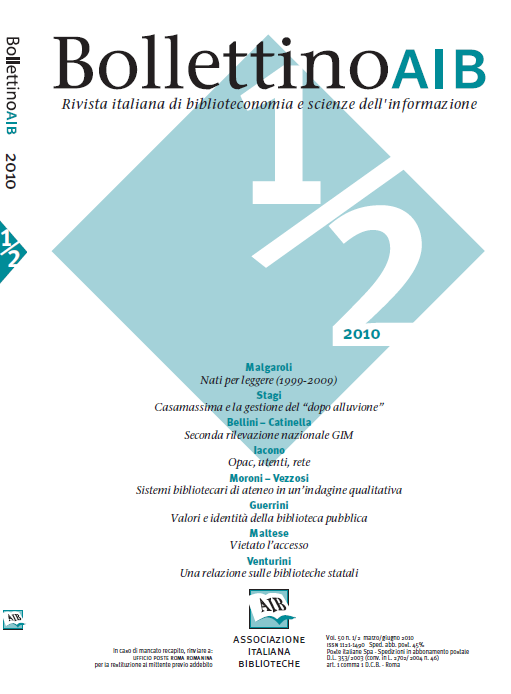Opac, users, web. Future developments for online library catalogues
Main Article Content
Abstract
The evolution of online library catalogues is deeply influenced by major changes in context involving users, documents and web. Today libraries are living in an age of profound change that forces them to replace themselves in an articulate and complex information scenario. In this important task the opac plays a significant role, representing a crucial access point to libraries and their content to the increasing remote users.
To enlighten the process of change taking place, we talk about opac enlarged, enriched, social opac and opac 2.0. Moving from two recent surveys concerning user expectations, the article focuses on some trends that are prominent in the recent international debate.
The above mentioned surveys suggest that enhanced and enriched content in opacs is often requested. Bibliographic enrichment is, therefore, a known practice, used to complete the catalogue records with evaluative content (abstracts, tables of contents, covers and fulltext) and investigation elements (link to online resources, biographies sites, ecc. ) This development line seems to consolidate in the face of growing users' need, which is no longer the simple representation of the document provided by a catalogue record.
After having briefly examined the evolutionary forms of the opac's expansion, the article discusses the new ways of designing user interfaces based on models derived from information seeking behaviour studies and intended to improve the overall process of research.
Then it looks at some of the new features and techniques that stand out as essential elements of new search interfaces in the so called "next generation catalogues"; these elements include relevance ranking, faceted navigation, search result clustering, and browsing features for the search environment.
New trends emerging from Web 2.0 and Library 2.0 issues are finally explored and lead to the suggestion of ways in which the catalogue may evolve though remaining a coherent and authoritative tool for the user as it has been so far.
To enlighten the process of change taking place, we talk about opac enlarged, enriched, social opac and opac 2.0. Moving from two recent surveys concerning user expectations, the article focuses on some trends that are prominent in the recent international debate.
The above mentioned surveys suggest that enhanced and enriched content in opacs is often requested. Bibliographic enrichment is, therefore, a known practice, used to complete the catalogue records with evaluative content (abstracts, tables of contents, covers and fulltext) and investigation elements (link to online resources, biographies sites, ecc. ) This development line seems to consolidate in the face of growing users' need, which is no longer the simple representation of the document provided by a catalogue record.
After having briefly examined the evolutionary forms of the opac's expansion, the article discusses the new ways of designing user interfaces based on models derived from information seeking behaviour studies and intended to improve the overall process of research.
Then it looks at some of the new features and techniques that stand out as essential elements of new search interfaces in the so called "next generation catalogues"; these elements include relevance ranking, faceted navigation, search result clustering, and browsing features for the search environment.
New trends emerging from Web 2.0 and Library 2.0 issues are finally explored and lead to the suggestion of ways in which the catalogue may evolve though remaining a coherent and authoritative tool for the user as it has been so far.
Article Details
Section
Articles

This work is licensed under a Creative Commons Attribution-ShareAlike 4.0 International License.
